HTC Thunderbolt Review: The First Verizon 4G LTE Smartphone
by Brian Klug on April 27, 2011 12:12 AM EST- Posted in
- Smartphones
- HTC
- Verizon
- LTE
- 4G
- Android
- HTC Thunderbolt
- Mobile
- MDM9600
- MSM8655
Display
The display on the Thunderbolt is 4.3 inches and of the relatively standard WVGA (800x480) sort we’re used to seeing from Android phones. It’s a rather normal LCD-TFT panel, no fancy IPS or SAMOLED+ or Pentile like other phones that are starting to headline. As a result, it doesn’t really impress in the numbers department, delivering relatively middling contrast that isn’t insufficient but doesn’t make it a standout performer by any means.
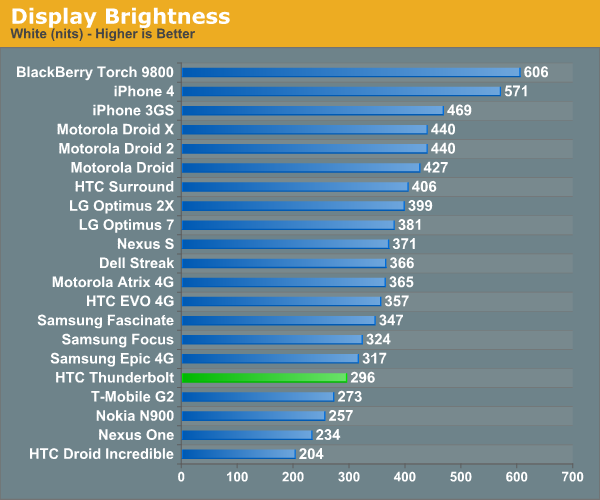
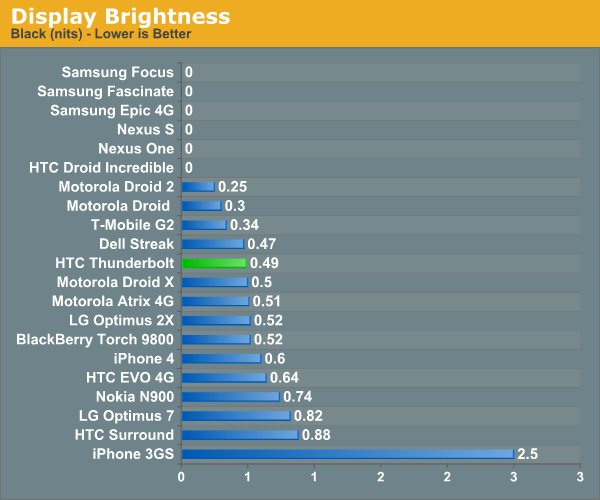

The other part of the picture is that qHD is rapidly becoming a feature that every next generation Android needs to have. In this regard as well as lack of dual core, the Thunderbolt feels a bit like it belongs to this current generation of smartphones rather than the upcoming one.
Absence of qHD isn’t a huge breaking point however since it still isn’t an officially sanctioned Android resolution. Though the official Android screen resolution guidelines have all manners of DPI-independent functionalities and four different display pixel densities, it’s ultimately up to each developer to implement proper pixel density agnosticism properly. In my time with the Arix for example, I’ve already seen a few applications that clearly have hard coded pixel values for UI elements and look weird.
Again by virtue of the Thunderbolt having a relatively ordinary LCD display, it also doesn’t have anything overwhelmingly awesome for viewing angles inside or out.
I grabbed a photo of the Thunderbolt outside right next to a Verizon 4G LTE eNodeB as well, and you can really see how outdoor viewing looks.
One of the only major gripes I have with the Thunderbolt is that there is noticeable light bleed from the capacitive button white LEDs that makes it onto the display surface. At the right angle, you can clearly see the reflection from the two LEDs that light up those buttons.
This is something which used to plague HTC’s designs way, way back, and I’m surprised to see it crop up again. It isn’t super noticeable, but it’s there if you look for it.


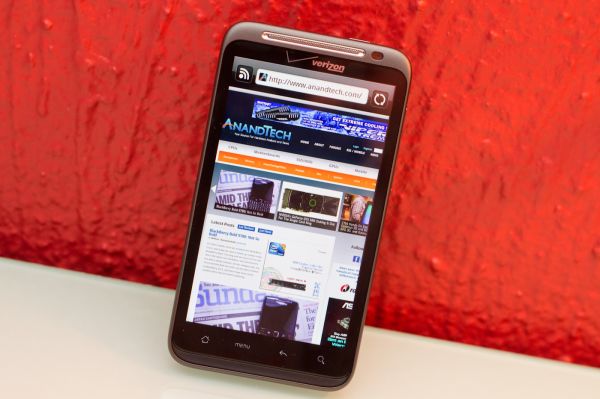
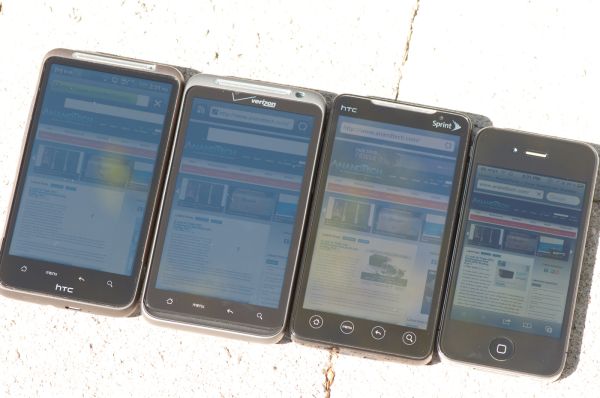
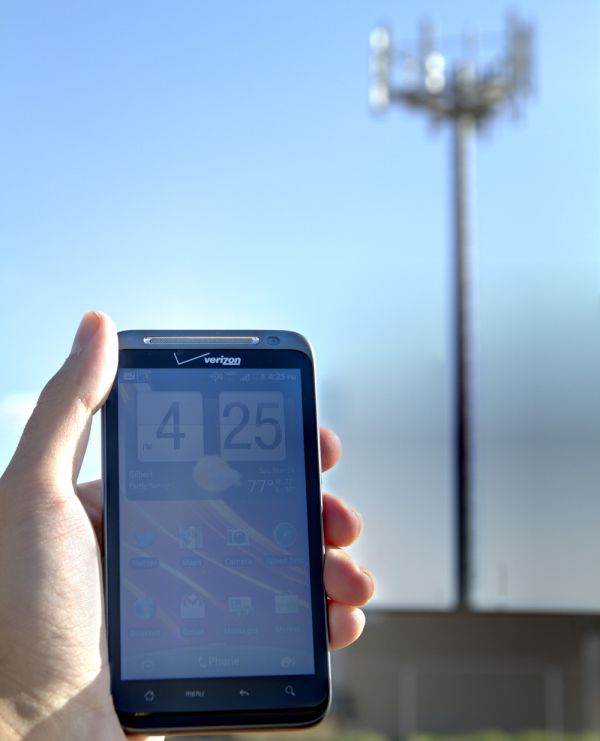
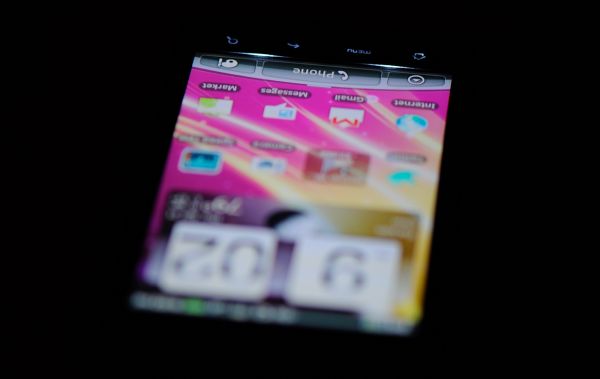








71 Comments
View All Comments
cmdrdredd - Thursday, April 28, 2011 - link
Or if you're stuck on an old android phone that has no memory, hardly any cpu or gpu power, and bogs down heavily all the time thanks to the new OS revisions not being highly optimized for slower phones (no upgrade path even for some too), and you decided you don't want to be a slave to Apple and what they decide you can and cannot have/do with the device, you might look at this for your upgrade if you were itching right now. Why wait for June to see the new Droid Bionic when you need a phone now that works properly and is faster?deputc26 - Wednesday, April 27, 2011 - link
Now THIS is a smartphone review. This is the meticulous quantitative data that I keep coming back to Anandtech for. Would like to see real world load times of real web sites though.7Enigma - Wednesday, April 27, 2011 - link
Seconded. I'm not a huge fan of smartphones (I don't own one and normally just skim the reviews for hardware/OS information) but this one reminded me of old-school Anandtech. Nitty-gritty detail and substance that anyone can tell required a LONG time to write.And factoring in the legitimate excuse of being ill made it all the more impressive.
Great job again Brian.
kurt-o - Wednesday, April 27, 2011 - link
The article stated "Remember that although the HTC EVO 4G could have conceivably supported simultaneous 4G WiMAX and 1x voice, the feature was disabled and to my knowledge hasn’t ever been enabled. It’s for this reason - until the Thunderbolt no proper procedure for characterizing dual transceiver phones existed."Unless I'm confused here, the article appears to have a blatant error. The HTC EVO 4G supports simultaneous 4G WiMAX and 1x-Voice. Has since day 1.
metafor - Wednesday, April 27, 2011 - link
I think what's meant is that it can't do simultaneous voice and data over 3G, which is true. If you are in a 4G area, I believe the Evo can use WiMax for data and 3G for voice.Brian Klug - Wednesday, April 27, 2011 - link
Are you certain? Although I have an EVO I'm not in a WiMAX market, so I can't test for certain. I know that WiFi + 1x voice is a definite go, 1x voice + EVDO is a no, but I was under the impression again that 1x voice + WiMAX is also a no.From the user manual:
"Can I make calls and use data services at the same time?
You cannot use voice and data services simultaneously. If you receive a call while data service is active, your device forwards the call to voicemail. You can place an outgoing call anytime, but it will interrupt any in-progress data session."
-Brian
privater - Wednesday, April 27, 2011 - link
Does this phone have a nuclear battery as accessory?ompaidjo - Tuesday, May 3, 2011 - link
:DI kept thinking about the same thing, since I bought this phone..
strikeback03 - Tuesday, May 3, 2011 - link
It isn't great, but then again I'd say that if you need several hours of web browsing time per charge a smartphone is probably not the right device for you anyway.ltcommanderdata - Wednesday, April 27, 2011 - link
4G brings better speed for the end user, but sometimes I wonder if I'd be more worthwhile to invest instead in existing 3G infrastructure to ensure wide area, consistent 3G coverage at the upper speed spec of 3G rather than focus on 4G peak speeds in some areas. I guess 4G is more worthwhile on CDMA networks where the speed disparity is greater than on GSM networks where up to 14Mbps HSPA vs LTE isn't as big a difference in usability.On an unrelated note, your benchmark charts don't seem to include the updated iOS 4.3 results that say the previous Dell Venue Pro review had. The updated browser in iOS 4.3 compared to iOS 4.2 makes a material difference in the benchmarks.